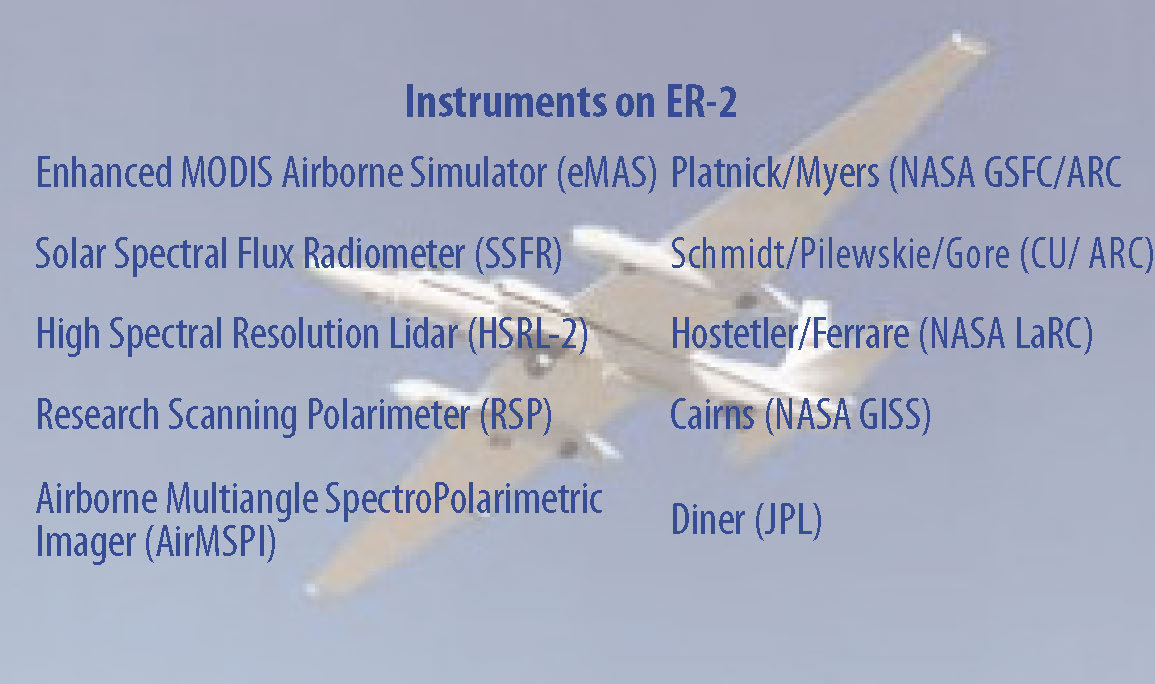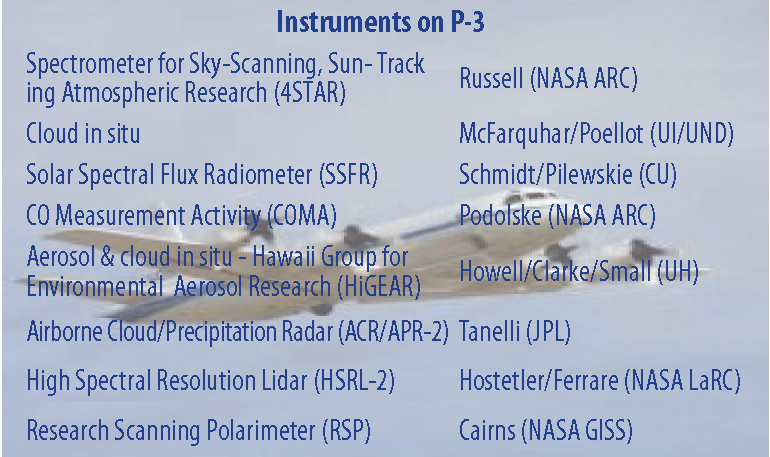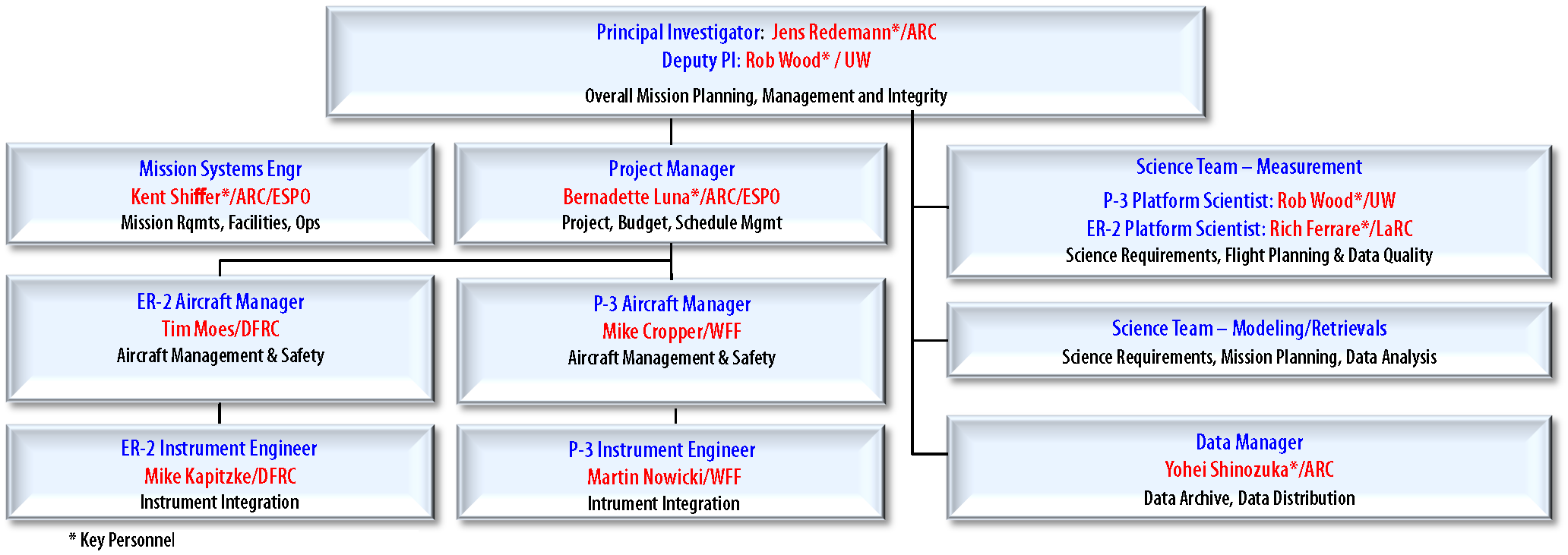ORACLES Science Overview
The proposed ORACLES study area in the SE Atlantic is a prime location to study aerosol- cloud interactions, because it hosts some of the largest aerosol optical depths (AOD) on the planet. Inter-model differences in aerosol and cloud distributions, as well as their combined climatic effects in the SE Atlantic are partly due to the persistence of aerosols above clouds (AAC). Globally, AAC increase estimates of AOD by 25±6%, but AAC in the SE Atlantic regularly dominate the atmospheric columnar burden. Satellite assessments of aerosols above and near clouds are often inadequate for assessments of aerosol impacts on climate, with in situ datasets needed for satellite retrieval validation and development, as well as model process evaluation and parameterization. The varying separation of cloud and aerosol layers to be sampled during ORACLES allow for a process-oriented understanding of how variations in radiative heating profiles impact cloud properties, which is expected to improve simulations for other remote regions experiencing long-range aerosol transport above clouds. Since previous efforts to study BB emissions in Southern Africa were largely focused on land or in the coastal zone, there is a dearth of measurements over the SE Atlantic Ocean, where the major radiative impacts of BB aerosols take place. Airborne observations are critically needed to understand and quantify the different ways in which BB aerosols affect the regional radiation balance. Taken at high resolution and over scales that resolve processes of interest, airborne measurements provide important constraints for parameterizing aerosol-cloud-climate interactions in models.
 Building on experience in the SAFARI-2K experiment, we use the NASA P-3 as a low-flying platform for simultaneous in situ and remote sensing measurements of aerosols and clouds in all three campaigns, supplemented by ER-2 remote sensing in one of the three flight years. The ER-2 combination of polarimeter, radar and lidar instruments will provide a testbed for the ACE (Aerosol Cloud Ecosystems) Decadal Survey Mission. The ER-2 observations are used to enhance satellite-based remote sensing, immediately by resolving variability within a particular scene, and in the long term by guiding the development of new and improved remote sensing techniques. The ORACLES baseline mission consists of measurements and modeling of direct, semi-direct and indirect aerosol effects on climate;
Building on experience in the SAFARI-2K experiment, we use the NASA P-3 as a low-flying platform for simultaneous in situ and remote sensing measurements of aerosols and clouds in all three campaigns, supplemented by ER-2 remote sensing in one of the three flight years. The ER-2 combination of polarimeter, radar and lidar instruments will provide a testbed for the ACE (Aerosol Cloud Ecosystems) Decadal Survey Mission. The ER-2 observations are used to enhance satellite-based remote sensing, immediately by resolving variability within a particular scene, and in the long term by guiding the development of new and improved remote sensing techniques. The ORACLES baseline mission consists of measurements and modeling of direct, semi-direct and indirect aerosol effects on climate;  the study of direct and semi-direct effects comprises the threshold science mission. ORACLES is directly relevant to the NASA Earth Science focus area “Atmospheric Composition,” because it contributes detailed, accurate observations of aerosol and cloud microphysical properties in the SE Atlantic. By providing observationally based estimates of instantaneous direct aerosol radiative effects and process-level understanding of semi-direct and indirect effects of aerosols on clouds, ORACLES is highly relevant to the NASA Earth Science focus area “Climate Variability and Change.” Direct measurements and modeling of aerosol and cloud effects on atmospheric heating rates and the regional hydrological cycle make ORACLES critical to the NASA Earth Science focus area “Water and Energy Cycles.”
the study of direct and semi-direct effects comprises the threshold science mission. ORACLES is directly relevant to the NASA Earth Science focus area “Atmospheric Composition,” because it contributes detailed, accurate observations of aerosol and cloud microphysical properties in the SE Atlantic. By providing observationally based estimates of instantaneous direct aerosol radiative effects and process-level understanding of semi-direct and indirect effects of aerosols on clouds, ORACLES is highly relevant to the NASA Earth Science focus area “Climate Variability and Change.” Direct measurements and modeling of aerosol and cloud effects on atmospheric heating rates and the regional hydrological cycle make ORACLES critical to the NASA Earth Science focus area “Water and Energy Cycles.”
Science Questions and Related Objectives
- Q1: What is the direct radiative effect of the African BB aerosol layer in clear and cloudy sky conditions over the SE Atlantic?
- O1-1: Determine the evolution of the BB aerosol microphysical and spectral radiative properties as the aerosol is transported across the South Atlantic.
- O1-2: Measure aerosol-induced spectral radiative fluxes as a function of cloud albedo and aerosol properties.
- O1-3: Assess the key factors that control the seasonal variation in aerosol direct effects.
- Q2: How does absorption of solar radiation by African BB aerosol change atmospheric stability, circulation, and ultimately cloud properties?
- O2-1: Determine the seasonally varying relative vertical distributions of aerosol and cloud properties as a function of distance from shore.
- O2-2: Constrain aerosol-induced heating rates for aerosol layers above, within and below cloud.
- O2-3: Investigate the sensitivity of cloud structure and condensate to aerosol-induced heating rates.
- Q3: How do BB aerosols affect cloud droplet size distributions, precipitation and the persistence of clouds over the SE Atlantic?
- O3-1: Survey the location and extent of aerosol mixing into the boundary layer (BL) and its seasonal variation.
- O3-2: Measure changes in cloud microphysical properties, albedo and precipitation as a function of aerosol mixing into the BL.
- O3-3: Investigate the sensitivity of cloud structure and condensate to aerosol-induced suppression in precipitation.
ORACLES is a joint project involving five NASA centers and eight US universities. Areas of expertise covered by the ORACLES science team include field observations of all relevant aerosol, cloud and meteorological processes, satellite remote sensing, and modeling at regional and large eddy simulations (LES) scales. Coordination with thematically related projects proposed to the UK NERC (Natural Environment Research Council) and the US NSF (National Science Foundation) is expected to take place in 2016 or 2017.

